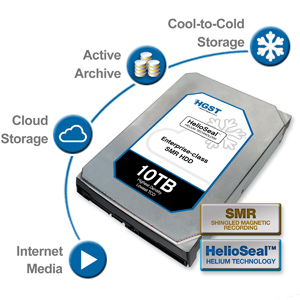Why 10TB drives could be bad news
In this week's news, Hitachi GST (HGST) announced a 10 TB HDD. It ups the earlier announcement by Seagate of a 8 TB disk. Although both companies claim the disks are "shipped", they are nowhere near consumers yet. Both are shipping samples to a select few partners. Tech writers are ecstatic, though, and are happily re-publishing most of the official press release.
10 TB in a 3.5" HDD is an impressive feat in itself, however the technology used to achieve it might mark the end of general purpose magnetic disks: First, this is another helium based disk from HGST, which stacks seven platters. It remains to be seen how long the helium can be contained within the disk, but is probably a lot shorter than the shelf-life of an air-based magnetic disk. Regardless of lifespan, what makes the 10 TB milestone less impressive, and even slightly worrisome, is the seven platters. That is a one-time trick. We cannot expect disks with even more platters stacked on top of each other in the future, so growth will not continue that route. It has to come from increased areal density of the bits per platter.
The brings me to the second issue with this disk: Areal density is achieved by so called Shingled Magnetic Recording (SMR). As explained by Seagate, it means that each data track is stacked slightly above the other, just like shingles on a roof. To make this work, existing data has to be re-written if something is changed in neighboring tracks. This could result in delays when writing data on an almost full disk. Furthermore, it will require special handling by the OS (in case of the "host managed" 10 TB HGST disk). Implementing that right might not be trivial. SMR based disks are in other words not drop-in replacements for all applications. Although, for scenarios which are write once (or infrequently), and read often, this is not a problem.
Combined, these two technologies will most likely take us to 20 TB and beyond. Assuming the 8 TB Seagate disk used five 1.6 TB platters, a seven platter disk would give 11.2 TB. That is of course the advantage of more platters, it amplifies any advance in areal density. Between five and seven platters, the factor is 1.4, and between four and seven it's 1.75.
The trend of ever decreasing HDD prices will continue, even though the products might not be for everyone.
